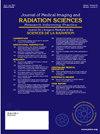Does Correction factor based T10 atlas help to achieve quick and improved Ktrans computation? a feasibility study
IF 1.3
Q3 RADIOLOGY, NUCLEAR MEDICINE & MEDICAL IMAGING
Journal of Medical Imaging and Radiation Sciences
Pub Date : 2024-10-01
DOI:10.1016/j.jmir.2024.101495
引用次数: 0
Abstract
Introduction
The ultrafast dynamic contrast-enhanced magnetic resonance imaging (DCE-MRI) used for Pharmacokinetic (PK) analysis is an effective method to predict benign and malignant tumor. Attempts have been made to achieve an accurate Ktrans by correcting T10, a major factor that influence Ktrans computation.
Purpose
The purpose of this study to develop a correction factor atlas database at every spatial-location (x,y coordinate) in both side of the mMR breast coil cuff space to improve T10 homogeneity in the reference method using multiple tube phantom by SW based automation.
Method
Both multiple tube phantoms (61 tubes in each phantom) and patient's studies were acquired on simultaneous PET/MRI Biograph mMR system (Siemens, Erlangen, Germany) by using 4 channel mMR breast coil. Each spatial location correction factors (2916 each side, total 4392 correction factors) derived from multiple tube phantom were assign to an inhouse developed software (Radvista, version 3.2.95) that compute Ktrans in few seconds. A retrospective analysis of DCE-MRI data acquired for 60 seconds of 146 patients with mean age of 50 years (24-80 years) having 178 enhancing histologically proved breast lesions forms the material of the study.
Results
Corrected and non-corrected ROC curve analysis revealed a mean Ktrans, ve value of 1.52 min-1, 0.44 & 1.16 min-1, 0.34 respectively. The sensitivity, specificity and overall accuracy of Ktrans for non-corrected data were 89.06%, 74.00% and 84.83% respectively and for corrected data it was 89.84%, 86.00%, and 88.76% respectively. The AUC of corrected data was improved to 0.927 (95% CI 0.878 to 0.960) from 0.893 (95% CI 0.839 to 0.935) for non-corrected data.
Conclusion
Spatially normalized T10 values derived from correction factor based T10 atlas in a reference method can provide a quick estimation of Ktrans with improved diagnostic accuracy.
基于校正因子的 T10 图集是否有助于实现快速、改进的 Ktrans 计算?
导言用于药代动力学(PK)分析的超快速动态对比增强磁共振成像(DCE-MRI)是预测良性和恶性肿瘤的有效方法。本研究的目的是在 mMR 乳房线圈袖带空间两侧的每个空间位置(x,y 坐标)上开发一个校正因子图集数据库,以便通过基于 SW 的自动化方法,在使用多管模型的参考方法中提高 T10 的均匀性。方法在 PET/MRI Biograph mMR 系统(西门子,德国埃尔兰根)上使用 4 通道 mMR 乳房线圈同时获取多管模型(每个模型中有 61 个管)和患者的研究结果。将从多管模型中得出的每个空间位置校正因子(每侧 2916 个,共 4392 个校正因子)分配给内部开发的软件(Radvista,3.2.95 版),该软件可在几秒钟内计算出 Ktrans。对 146 名平均年龄为 50 岁(24-80 岁)、有 178 个经组织学证实的乳腺增强病灶的患者 60 秒内获得的 DCE-MRI 数据进行了回顾性分析。未校正数据的 Ktrans 的灵敏度、特异性和总体准确度分别为 89.06%、74.00% 和 84.83%,校正数据的灵敏度、特异性和总体准确度分别为 89.84%、86.00% 和 88.76%。校正数据的 AUC 从未修改数据的 0.893(95% CI 0.839 至 0.935)提高到 0.927(95% CI 0.878 至 0.960)。
本文章由计算机程序翻译,如有差异,请以英文原文为准。
求助全文
约1分钟内获得全文
求助全文
来源期刊

Journal of Medical Imaging and Radiation Sciences
RADIOLOGY, NUCLEAR MEDICINE & MEDICAL IMAGING-
CiteScore
2.30
自引率
11.10%
发文量
231
审稿时长
53 days
期刊介绍:
Journal of Medical Imaging and Radiation Sciences is the official peer-reviewed journal of the Canadian Association of Medical Radiation Technologists. This journal is published four times a year and is circulated to approximately 11,000 medical radiation technologists, libraries and radiology departments throughout Canada, the United States and overseas. The Journal publishes articles on recent research, new technology and techniques, professional practices, technologists viewpoints as well as relevant book reviews.
 求助内容:
求助内容: 应助结果提醒方式:
应助结果提醒方式:


